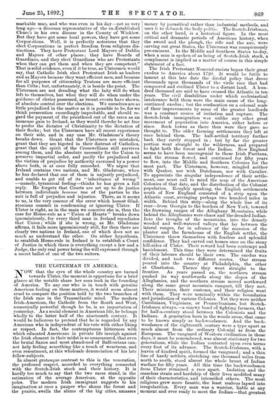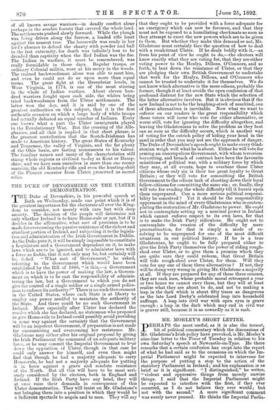THE 17LSTERMAN IN AMERICA. N OW that the eyes of the
whole country are turned towards Ulster, the moment is opportune for a brief glance at the notable share her sons took in the founding of America. To any one who is in touch with genuine American feeling on these matters, it would seem almost cruel to compare the position held by the two branches of the Irish race in the Transatlantic mind. The modern Irish-American, the Catholic from the South and West, numerically powerful though he be, is an importation of yesterday. As a social element in American life, he belongs wholly to the latter half of the nineteenth century. It would be ludicrous to pretend that he is regarded by any American who is independent of his vote with either liking or respect. In fact, the contemptuous bitterness with which educated Americans in private life inveigh against the Irish element in their midst is so unmeasured, that even the brutal Saxon and most abandoned of Balfourians can- not help feeling something like a touch of weariness, and even resentment, at this wholesale denunciation of his late fellow-subjects. In almost grotesque contrast to this is the veneration, the profound respect, accorded to everything connected with the Scotch-Irish stock and their history. It is hardly too much to say that the two races stand, in the estimation of the average American, at the opposite poles. The modern Irish immigrant suggests to his imagination at once a pauper who shuns the forest and the prairie, swells the slums of the big cities, amasses money by parasitical rather than industrial methods, and uses it to debauch the body politic. The Scotch-Irishman, on the other hand, is a historical figure. In the most critical and dramatic periods of American history, when the sword and the plough, the rifle and the axe, were carving out great States, the Ulsterman was conspicuously pre-eminent. In the Middle and Southern States to-day, when a man is spoken of as being of Scotch-Irish stock, a compliment is implied as a matter of course in this simple statement of a fact.
The Irish Protestant Nonconformists began their great exodus to America about 1720. It would be futile to lament at this late date the direful policy that drove thousands upon thousands of the virile race that had conquered and civilised Ulster to a distant land. A hun- dred thousand are said to have crossed the Atlantic in ten . years. The civil disabilities under which ecclesiastical intolerance held them were the main cause of the long- continued exodus ; but the confiscation on a colossal scale of their improvements by some of the greater landlords was a constant source of irritation and rupture. The Scotch-Irish immigration was unlike any other great movement of population into America, either before or since. Such towns as there then were they gave no thought to. The older farming settlements they left at once behind them. The half-settled territory further back they rarely stopped in ; but by far the greater portion went straight to the wilderness, and prepared to fight both the forest and the Indian. New England seems to have been uncongenial to these Irish Puritans, and the stream fluwed, and continued for fifty years to flow, into the Middle and Southern Colonies for the most part. The Ulstermen, however, mingled. neither with Quaker, nor with Dutchman, nor with Cavalier. To appreciate the singular independence of their settle- ment, one must call to mind the map of the American Colonies of that date, and the distribution of the Colonist population. Roughly speaking, the English settlements south of New England consisted of a strip upon the Atlantic coast, averaging perhaps two hundred miles in width. Behind this strip—along the whole line of its - rear—from Georgia to the borders of New York, towered. the frowning ranges of the Alleghany Mountains, while behind the Alleghanies were chaos and the dreaded Indian. Into the troughs of the mountains, into the densely wooded and well-watered valleys that lay between the lateral ranges, far in advance of the mansion of the planter and the farmhouse of the English settler, the Ulstermen threw themselves with fearless and splendid confidence. They had carved out homes once on the stony hill-sides of Ulster. Their reward had been contempt and banishment. This time they were determined the fruits of their labours should be their own. The exodus was divided, and took two different routes. One stream poured into the country at Philadelphia, the other at Charleston. Thence they went straight to the frontier. As years passed on, the northern stream pushed its way southwards along the slopes of the Alleghanies, and the southern stream moved northward along the same great mountain rampart, till they met. Their ministers, their customs, and their religion went with them. They were nominally within the boundaries and jurisdiction of various Colonies. Yet they were neither Carolinians, Virginians, or Pennsylvanians, but Scotch- Irishmen always,—a sinewy band of fighting farmers, that for half-a-century stood between the Colonists and the Indians. A generation born in the woods arose, that came- to be known simply as backwoodsmen. And the back.. woodsmen of the eighteenth century were a type apart as much almost from the ordinary Colonial as from the European. The vanguard of Western civilisation in those days, it must be remembered, was almost stationary for two generations, while the Indian contested upon even terms every foot of its advance. The Scotch-Irishman, with a leaven of kindred spirit, formed the vanguard ; and a thin line of hardy settlers, stretching one thousand miles from north to south, stood almost the whole brunt of Indian warfare for fifty years. All this time the backwoodsmen from Ulster remained a race apart. Isolation and the ceaseless strain and hardship of their lives modified many of their characteristics, and intensified others. The most religious grew more fanatic, the least zealous lapsed into irregularities. Every man was a warrior, liable at any moment and ever ready to meet the Indian—that greatest of all known savage warriors—in deadly conflict alone perhaps in the sombre forests that covered the whole land. The settlements pushed slowly forward. While the plough was being driven along the furrow, a loaded rifle leant against the nearest tree. The housewife was ready in her lord's absence to defend the shanty with powder and ball to the last extremity, for death was infinitely less to be dreaded than captivity when the Red Indian was the foe. The Indian in warfare, it must be remembered, was really formidable in those days. Regular troops, or ordinary Colonial militia, were at his mercy in the woods. The trained backwoodsman alone was able to meet him, and even he could not do so upon more than equal terms. The great fight at the Greenbriar levels, in West Virginia, in 1774, is one of the most stirring in the whole of Indian warfare. About eleven hun- dred warriors fought upon each side, the whites being tried backwoodsmen from the Ulster settlements. The latter won the day, and it is said by one of the greatest authorities on this subject, that it is the first authentic occasion on which a large body of white troops had actually defeated an equal number of Indians. Every one knows what a part the Ulster immigrants played in the Revolutionary War. But the crossing of the Alle- ghanies, and all that is implied in that short phrase, is the greatest contribution that the Scotch-Irishman has made to American history. The great States of Kentucky and Tennessee, the valley of Virginia, and the fat plenty of the Ohio basin, are lasting monuments to his valour. The familiar names and many of the characteristics still stamp whole regions as civilised to-day as Kent or Hamp- shire, and we have seen ourselves in more than one roomy mansion, the old Kentucky rifle and even the hunting-shirt of the Pioneer ancestor from Ulster, preserved as sacred relics.



































 Previous page
Previous page